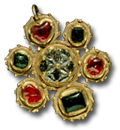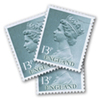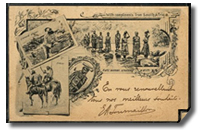Diamond History
|

Enameled gold pendant with a central diamond rosette formed by 12 diamonds, surrounded by rubies and emeralds; 16th century; 5.2 cm across. | The Greek word "Adamas" meaning unconquerable and indestructible is the root word of diamond. Diamonds have been searched the world over, fought over, worshipped and used to cast love spells The ancient Greeks believed that diamonds were splinters of stars fallen to the earth. It was said by some that they were the tears of the Gods. They also believed the fire in the diamond reflected the constant flame of love. |
The first river-bed (alluvial) diamonds were probably discovered in India, in around 800 B.C. The volcanic source of these diamonds was never discovered, but the alluvial deposits were rich enough to supply most of the world’s diamonds. | The ancient Greeks believed that diamonds were splinters of stars fallen to the earth
 |
|

Diamonds were probably discovered in India, in around 800 B.C | For centuries, rough diamonds were kept as talismans, and often not worn at all, though natural octahedral (eight-sided stones) were sometimes set in rings. A Hungarian queen’s crown set with uncut diamonds, dating from approximately l074, is perhaps the earliest example of diamond jewelry. The earliest record of diamond polishing (with diamond powder) is Indian, and probably dates from the fourteenth century. We also know that the royalty of France and England wore diamonds by the late 1300’s.
In 1477, Archduke Maximilian of Austria gave a diamond ring to Mary of Burgundy, thus, starting the tradition of diamond engagement rings. The reason a woman wears it on the third finger of her left hand dates back to the Egyptian belief that the vena amoris (vein of love) ran directly from the heart to the top of that finger. |
|

A Hungarian queen’s crown set with uncut diamonds, dating from approximately l074, is perhaps the earliest example of diamond jewelry. |
| | The earliest producing diamond mines were in the Golconda region of India. Jean Baptiste Tavernier, a Frenchman, is credited with the discovery of the first gemstone in the region in 1627. Mining was well-established by the mid-seventeenth century and a single mine employed 60,000 persons to dig and carry the alluvial gravels that contained the diamonds. | 
Royalty of England wore diamonds by the late 1300’s |
|

Diamond cutting facility in Africa | In 1867, a 21 carat stone discovered on the banks of the Orange River, South Africa, started a great diamond rush. Between 1870 and 1891, no less than six kimberlite pipes were discovered in Kimberley. The biggest pipe in South Africa was discovered at Cullinan, near Pretoria, in 1902. The world’s largest gem diamond, a 3,106 carat stone, was found there in 1905. |
|
In 1939 De Beers introduced the criteria for Diamonds determining the gem quality by a combination of four distinct factors. These are called the 4C’s. Cut, Color, Carat and Clarity (see section on the 4C’s)
In the 1950’s, Yakutia, a region of the Soviet Union, began to develop newly discovered diamond resources. This Siberian diamond field would make their nation one of the greatest diamond producers of all time. | 
An old South Africa mining permit |
|
In the 1960’s, diamond fields were discovered in Botswana. The three diamond mines - Orapa, Letlhakane and Jwaneng - make Botswana the world’s second-largest producer of diamonds and the largest producer of gem diamonds by both value and number.

Largest land staking rush in Canadian mining history when the kimberlite pipe was drilled at Lac de Gras, N.W.T., Canada
In 1991, a diamond-bearing kimberlite pipe was drilled at Lac de Gras, N.W.T., Canada to begin the largest land staking rush in Canadian mining history. Production of the BHP/DiaMet pipes began in 1998. Work to date indicates several pipes have gem diamond concentrations and valuations as rich as diamond mines in Africa.
|




